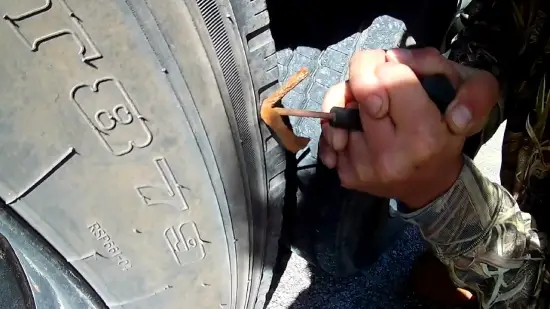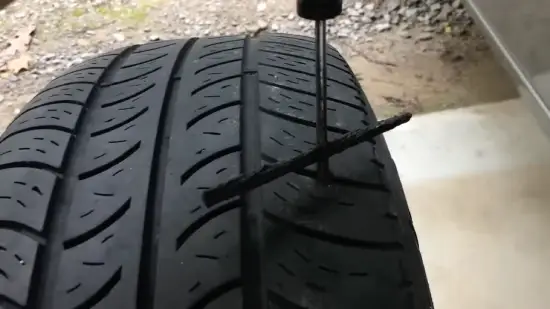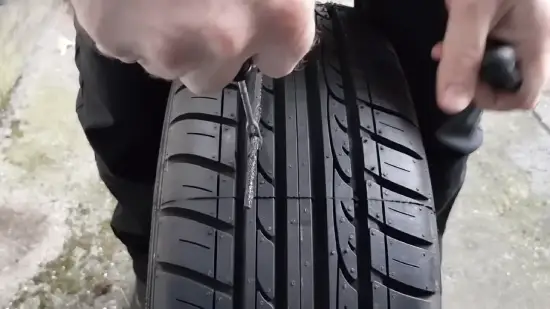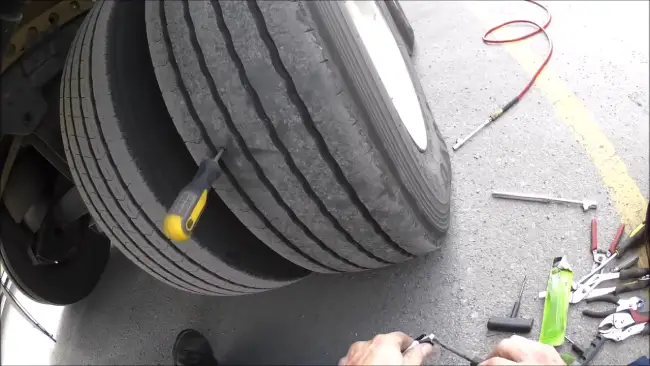Last Updated on July 26, 2023
A flat tire can be one of the most troublesome scenarios when towing a trailer. Not only can it leave you stranded on the side of the road, but it can also cause damage to your trailer.
But, it is possible to plug a trailer tire and get back on the road quickly. Approach the work at hand with caution and formality.
Today we go into plugging a trailer tire and the procedures you must follow for safety on the road. Discover the dangers of driving on plugged tires and whether towing a trailer with a blown tire is feasible.
What Is the Procedure for Plugging a Trailer Tire?

The process of plugging a trailer tire requires precision and careful execution. To carry out this task effectively, it is crucial to adhere to the following guidelines:
- Step 1: Gather the Necessary Tools
- Step 2: Measure the Tread Depth
- Step 3: Remove the Wheel and Tire
- Step 4: Identify and Locate the Puncture(s
- Step 5: Widening the Hole and Insert Tire Plugs
- Step 6: Trim Excess Material and Check for Leaks
- Step 7: Inflate and Reinstall the Tire
Step 1: Gather the Necessary Tools
Before you start plugging your trailer tire, ensure you have all the tools you need to do the job right. This includes a tire plug kit, tire pressure gauge, and tread depth gauge. These tools will ensure you can quickly and efficiently repair your tire without any issues.
Step 2: Measure the Tread Depth
Now, it’s time to measure your tire’s tread depth using a tread depth gauge. This is a critical step because you must check if the tire is still safe. If the tread depth is below the recommended level, it may be time to replace the whole tire instead of attempting a repair.
Step 3: Remove the Wheel and Tire
Next, use your trusty jack and jack stand to lift the trailer tire off the ground. Make sure the trailer is stable and secure before proceeding. Once the tire is off the ground, remove the wheel and tire so you can gain better access to the puncture(s) in the tire.
Step 4: Identify and Locate the Puncture(s)
Take a close look at the tire and carefully inspect for nails, screws, or other objects that may have caused the tire to deflate. Once you find the puncture(s), mark them so you can easily find them later.
Step 5: Widening the Hole and Insert Tire Plugs
With a reamer or drill bit from your tire plug kit, widen the hole in the tire to prepare for the plug. Ensure that you don’t damage the inner liner of the tire. Insert a tire plug into the hole using a plug insertion tool. Make sure the plug is completely inserted and secure.
Step 6: Trim Excess Material and Check for Leaks
Carefully remove any excess material from the tire plug using a razor blade or sharp knife, ensuring it is flush with the tire’s surface. After trimming, it’s crucial to check for any leaks. Use a mixture of soapy water and check for any bubbles. If any bubbles appear, it indicates a leak, and you need to reevaluate your repair.
Step 7: Inflate and Reinstall the Tire
If everything looks good and there’s no leak, then it’s time to reinflate your tire. Use an electric air compressor to inflate the tire to the recommended pressure specified by the manufacturer. Once you’re happy with the pressure level, attach the wheel and tire to the trailer, securing them firmly.
How Do You Tell if You Can Plug in a Tire?

Certain criteria apply to determine the possibility of plugging a tire. It is important to note that the puncture must be located within the tire’s tread area, as punctures on the edge or side of the tire are not eligible for repair.
Additionally, the puncture needs to have a diameter smaller than ¼ inch in diameter, as larger punctures won’t hold the plug securely and could lead to further damage. Another important consideration is how quickly the puncture is identified and repaired.
Punctures left without repair for too long may result in significant loss of air pressure, making it more difficult to repair the tire. Therefore, it is essential to regularly inspect tires for any signs of punctures and address them promptly to avoid further damage or safety risks.
What Are the Dangers of Driving on Plugged Tires?
Driving on plugged tires poses numerous dangers to both the driver and other road users. One of the major risks is structural failure, which can occur if the plug fails to seal the puncture properly, leading to loss of tire integrity.
Additionally, plugged tires are limited in reliability, which could result in uneven wear and handling issues, ultimately increasing the risk of accidents.
Structural Failures
Tire structural failures can lead to unsafe driving conditions, so ensure your trailer tires are maintained and inspected before every use. Trailer tires operate under high loads and can be subjected to various environmental conditions, such as extreme temperatures, that can cause structural damage.
Various factors, such as impact damage, corrosion, and overloading, can cause structural failures.
To prevent structural failures, it is essential to regularly inspect trailer tires for any signs of damage, such as punctures, cuts, bulges, cracking, or uneven wear. Here’s a breakdown of the common causes of structural failures in trailer tires and how to prevent them.
| Common Causes of Structural Failures | Preventive Actions |
| Impact Damage | Avoid hitting curbs, potholes, or other obstacles. |
| Corrosion | Clean tires regularly and avoid exposure to chemicals and saltwater. Use corrosion-resistant materials for rims. |
| Overloading | Check the load capacity rating of the tire and ensure that it is not exceeded. |
| Underinflation | Check tire pressure regularly and inflate to the recommended level. |
| Overinflation | Do not overinflate tires beyond the recommended pressure. |
| Age | Replace tires before they reach their maximum age limit, even if they appear to be in good condition. |
Loss of Tire Integrity
The vulnerability of tire integrity can have serious repercussions for trailer operators, including blowouts and other road hazards.
Plugged tires may lose their strength and structure, making them more susceptible to damage and less able to handle heavy loads. The plug can also create weak points in the tire’s internal structure, leading to a loss of structural integrity over time.
This loss of tire integrity can make it difficult for operators to detect potential issues with their tires before they become major safety hazards.
Some plugged tires look good on the surface, but they may be structurally compromised and at risk for blowouts. This is why trailer operators need to monitor their tires and ensure they’re regularly inspected and maintained.
Limited Reliability
Given the potential limitations of plugs, it is crucial to consider alternative solutions for maintaining the reliability of tires. Despite being convenient and cost-effective, plugs are only sometimes the most reliable option, especially for trailers with harsher conditions than typical passenger cars.
Due to extreme weather conditions, long distances, and rough terrain, plugs can fail unexpectedly and endanger drivers and passengers.
Increased Risk of Accidents
Despite the limited reliability of plugging a trailer tire, some individuals may still consider it a viable option. However, it is important to note that driving on a plugged tire introduces uncertainty and potential hazards. If you blow out a tire at high speeds or on busy roads, you’re at a higher risk of an accident.
There are several reasons why driving on a plugged trailer tire is risky. As a starter, the plug may not hold up to the pressure and weight of the trailer, causing it to fail unexpectedly. Furthermore, the plug may not completely seal the puncture, allowing air to leak out and deflate the tire.
Additionally, if multiple punctures or the plug needs to be properly installed, the tire may become unstable and difficult to control.
Uneven Wear and Handling Issues
Uneven wear and handling issues resulting from plugging a tire can compromise the vehicle’s stability and overall driving experience. When a tire is plugged, its internal structure may be weakened, leading to inconsistencies in its wear pattern. Tires can wear unevenly. As a result, reducing traction and stability.
In extreme cases, this can lead to a blowout or other accidents, putting the driver and passengers at risk.
Moreover, plugging a tire can also affect a vehicle’s handling, particularly during sudden turns or braking. The plugged tire may not be able to provide consistent traction, leading to difficulties in controlling the vehicle. This can also impact the vehicle’s braking performance, making it harder to stop promptly.
Is it possible to tow a trailer with a blown tire?

Towing a trailer with a blown tire is not recommended, as it can greatly affect the stability and control of the vehicle, potentially leading to dangerous situations on the road. A blown tire can cause the trailer to sway or even tip over, especially at high speeds or on uneven terrain.
This can damage the trailer and its contents and put the driver and other road users at risk of accidents. Moreover, a blown tire can also cause damage to the wheel and the suspension system of the trailer.
This can result in costly repairs and replacements that could have been avoided if the tire was replaced or repaired promptly. Before embarking on a journey, trailer tires should be in good condition, so any signs of wear or damage should be addressed immediately.
How long will a plugged tire last?
A properly installed plug can provide reliable service for seven to ten years or up to 25,000 miles. This lifespan can vary depending on several things, including the type of plug used, the size and location of the puncture, and driving conditions.
A plug that has been installed correctly and in the right location can offer a long-lasting repair, but if it needs to be sealed or installed right, it will only last for a while. To ensure the maximum lifespan of a plugged tire, it must be installed by a professional with the right tools and expertise.
Maintaining your tires regularly can help you catch problems before they get worse. Ultimately, while a properly installed plug can fix a trailer tire for a long time, it’s crucial to maintain and monitor it to ensure it keeps running smoothly.
Proper Trailer Tire Repair: Keep Yourself and Others Safe
When repairing punctured trailer tires, it is essential to follow the proper procedure. This is not only important for your safety but also for the safety of others on the road. Even though plugging a tire is a common solution, you must check the manufacturer’s guidelines first.
If it is, the next step is locating the puncture and removing foreign objects. A formal approach must be taken to insert the plug inside the tire, ensuring it is secure and airtight before reinflating to the recommended pressure.
It is essential to bear in mind that driving on plugged tires can be dangerous, as the plug may not hold or could cause further damage to the tire. Replacing the tire if it is severely damaged or has been repaired multiple times is recommended.
So as the saying goes, an ounce of prevention is worth a pound of cure. Formality is key in following the correct procedure.



